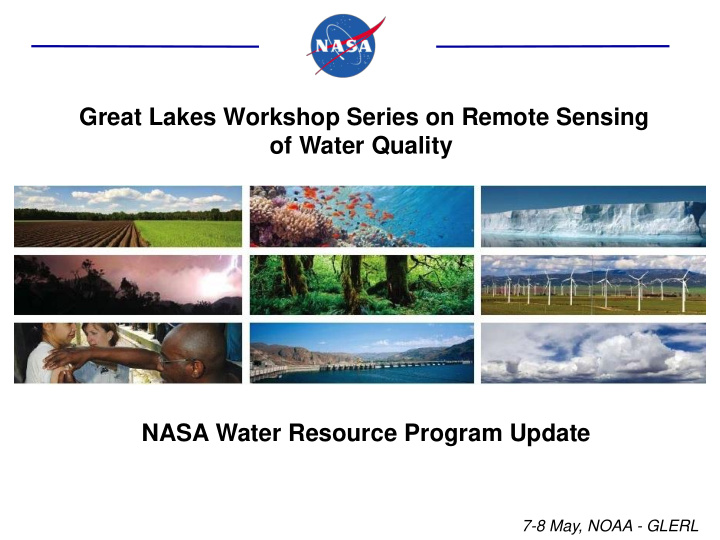



Great Lakes Workshop Series on Remote Sensing of Water Quality NASA Water Resource Program Update 7-8 May, NOAA - GLERL
NASA Applied Sciences Prog ram A Pathway Between Earth Science & Society Results of Uses by Partners NASA Earth and Stakeholder Science Research Communities GEOSS Societal Benefit Areas NASA Applied Sciences Program Natural Water Ecosystem Disast Resources s ers Air Agricultu re Qual ity Weather Public Climate Health
NASA Water Resource Applied Sciences The NASA Water Resources Program Element: The Water Resources Program Element addresses concerns and decision processes that are related to water availability, water forecast, and water quality . The goal of the Water Resources Program Element is to apply NASA satellite data to improve the Decision Support Tools (DSTs) of user groups that manage water resources. Implementation requires close and enduring partnerships with Federal agencies, academia, private firms, and international organizations. Water Resources Projects: Projects are tactical implementations led by Principle Investigators, driven by water management challenges, and ultimately sustained by water resource information stakeholders. Programmatic Activities: National and international activities to improve skills, share data and applications, and broaden the range of users who apply satellite data and Earth science in water resource 3 decisions.
NASA Water Resource Applied Sciences https://c3.nasa.gov/water/
NASA Partnership with NOAA on Harmful Algal Bloom Monitoring and Forecasts in Lake Erie Water Quality in Applied Sciences PI: Richard Stumpf – NOAA (HAQ) Highlight: A NASA-funded project, in collaboration with NOAA, produces Harmful Algal Bloom (HAB) products and forecasts based on NASA Partnership with NOAA on Harmful Algal Bloom observations from MODIS and (formerly) ESA MERIS for Lake Erie. HABs are of particular concern in drinking water and recreational Monitoring and Forecasts in Lake Erie water supplies due to potential toxin production. These products are processed in near-real time and available to end users (e.g, Ohio EPA, Ohio Department of Natural Resources, Toledo Water Supply, OBJECTIVE Sandusky Water Supply, Cuyahoga Department of Health) via a NOAA portal (http://www2.nccos.noaa.gov/COAST/). HAB forecasts are also Produce Harmful Algal Bloom distributed to end users online (http://www.glerl.noaa.gov/res/Centers/HABS/lake_erie_hab/lake_eri (HAB) products and forecasts e_hab.html) and via a subscriber distribution list on a weekly basis. Lake Erie, July 2009, during a HAB event. based on observations from MODIS and (formerly) ESA MERIS for Lake Erie. OPERATIONAL PARTNERS Relevance: Providing these data in an accessible manner has been valuable for end users in reducing the cost and impacts to the public Ohio EPA, Ohio DNR, Toledo of HABs along the coastline of Lake Erie. HABs degrade water quality, alter the food web, and produce toxins. The HABs associated with Water Supply, Sandusky Water Lake Erie produce a toxin that causes the following in humans: Supply, Cuyahoga Dept of Health, gastrointestinal illness (nausea, diarrhea, cramps), eye and skin NOAA irritation, and liver damage (with chronic exposure). This toxin has been known to cause renal failure in dogs within hours of ingestion. APP SCI INVESTIGATORS Highlight: Produced a bulletin for HABs that was Above: The upper left panel shows a HAB Bulletin forecast on September 8, 2011. This forecast stated that a massive HAB was R. Stumpf (PI) Linda Merchant-Masonbrink of the Ohio EPA, Division of Surface hosted by NOAA; this tool helped reduce the effecting the western basin of Lake Erie and was expected to Waters, stated that these products “minimize resources necessary for impact/costs to the public from HABs. According spread to the southeast. The lower right panel is a NASA MODIS large scale surveillance. [They] help us focus our resources.” to Ohio EPA, these products help focus and false color image from September 11, 2011. This image (with surface algal bloom denoted in green) confirms the southeastern minimize resources necessary for large scale spread of the HAB. surveillance
Water Quality in Applied Sciences (WR)
2 Current Opportunities for Supporting Great Lakes Activities in Applied Sciences Water Resources Solicitation Health and AQ solicitation Released as Element A.45 of Released as Element A.44 of NASA’s 2013 NASA’s 2013 Research Opportunities in Space Research Opportunities in Space and Earth Science and Earth Science Proposals due: April 30, 2014 Proposals due: April 24, 2014 http://nspires.nasaprs.com/external/ http://nspires.nasaprs.com/external www.c3.nasa.gov/water /
Upcoming Water Resources Applied Research Activities • PEER Water Initiative – USAID • Global Agriculture - GEOGLAM Next Phase – USDA • Sustainable Land Imaging - USGS – Study Report to Congress and OMB – Summer 2014 • NASA – WSWC Meeting – 18-20 Aug – JPL, Pasadena, CA • Water Resources Team Meeting – Fall 2014
CHALLENGE: What are other ways for AppSci to support the GL community in bridging research to operations? - Key partners? - Key water quality challenges (for the operational community, not just the science/research community)? - Models or analyses that can (within 2-3 years) become decision support tools or operationalized? - Can training help? - Other ideas?
Thanks to the GL community and GRC for organizing this workshop and for the opportunity to learn more about on-going work, activities, and potential synergies. Thanks to the Water Resources Applied Research Program Team: Forrest Melton, ARC John Bolton, GSFC Christine Lee, AAAS Fellow.
Remote Sensing for Drought Monitoring and Response Workshop February 25 th and 26 th , 2014 Sacramento Convention Center Sacramento, CA Jeanine Jones, CDWR DWR Photography Kelly Grow DWR Photography Kelly Grow 11 Tom Painter, JPL
Remote Sensing for Water Quality Stakeholder – Research Community Meetings?? Water Quality Stakeholder(s) EPA? State Depts? NGO’s? Private Sector? Water Quality Applied Research PI’s 12
Recommend
More recommend